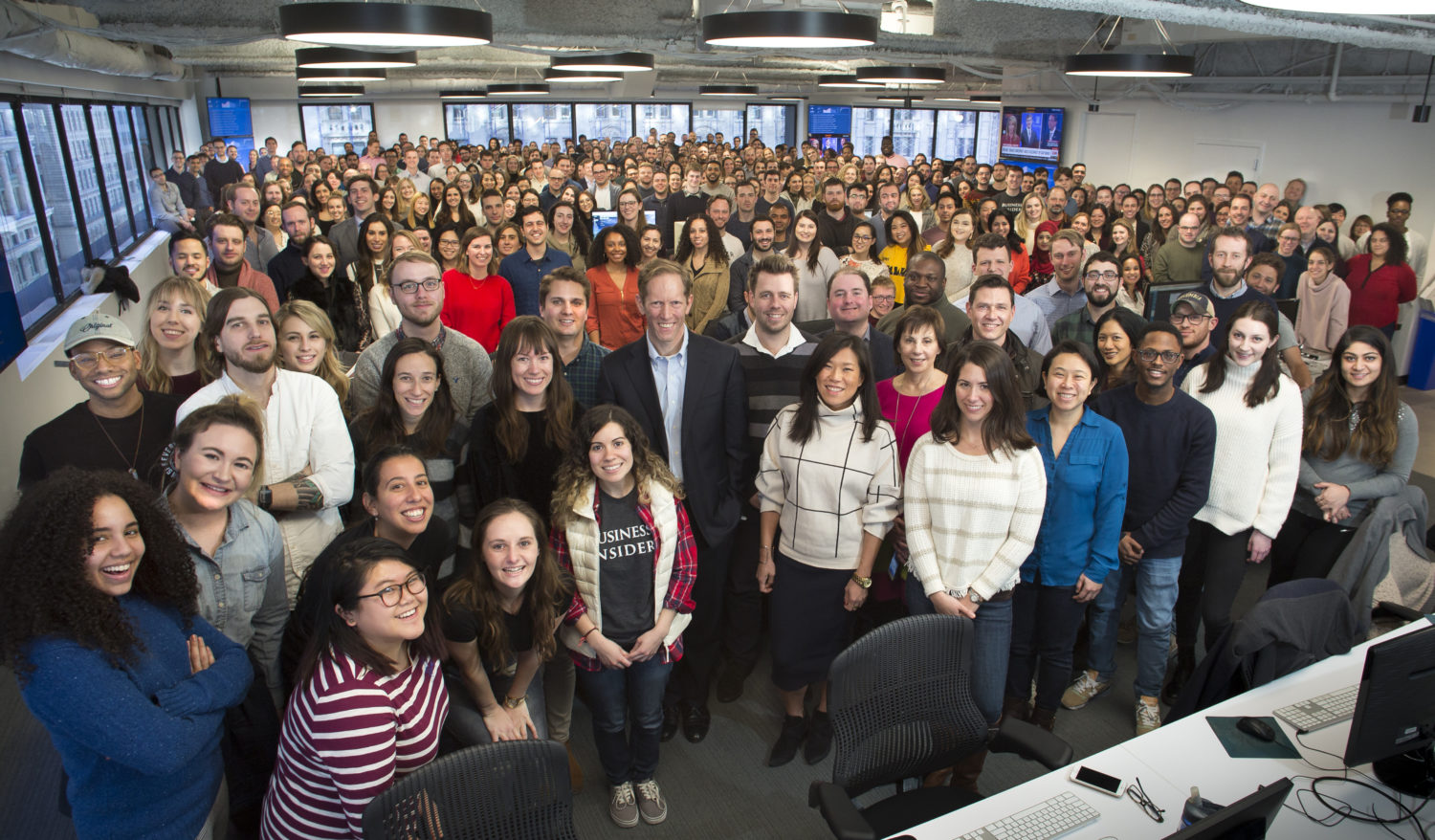Henry Blodget, co-founder and CEO of Business Insider/Insider Inc., summoned his staff last Thursday for a start-of-the-new decade meeting and laid on them three heavy growth targets for the next five years:
- A million paid subscribers (vs. about 200,000 now). Insider’s two main sites are free, but the company has also built out a premium intelligence site and a research business the last few years.
- Total unique visitors per month of a billion — calculated by including international and platform traffic. That compares to about 375 million currently, Blodget told me. The company’s U.S. traffic was just under 100 million in December according to Comscore.
- Employing 1,000 journalists and analysts, double its news staff now. Its site lists more than 100 job openings.
Wildly ambitious? Maybe. But in a conversation with me last week, Blodget shared that Business Insider has come along steadily from the proverbial garage, musing on a blog concept with a pair of partners (on a loading dock actually), to a diversified enterprise in the top rank of digital publishers.
A leading whiz kid tech industry analyst in the 1990s after growing up in New York and graduating from Yale, he remains a big-picture guy and a highly optimistic one about digital media generally.

Blodget buys the commonplace idea that the internet has disrupted everything in media — the next turn is coming for digital-only sites, broadcast and cable, too. But time and the investment cycle are on the side of well-positioned startups, he believes.
“Fifteen years ago investors were skeptical about digital content,” Blodget told me in a phone interview. “Then they got excited and (media industries) became grossly overcapitalized.” A shakeout is in progress but underlying demand remains strong, he said, joking “until Silicon Valley comes up with a way we can absorb it directly into our brain.”
The New York Times is well on its way to a sustainable model, he said, and he thinks the Insider group is getting there, too. “Local journalism is going to be the last piece of the puzzle, but we are beginning to see the seeds (of success). It’s a market we hope to get into in another few years.”
German publishing giant Axel Springer acquired the company, after a smaller initial stake, for $343 million (closer to $450 million including debt) in September 2015 and retained Blodget as CEO. In a fairly standard arrangement for founders who sell and stay, he wins equity bonuses as the company within a company grows.
Insider Inc., the new umbrella name for the businesses, just hit a target for revenue diversification, Blodget said, with about a third from ads, a third from subscriptions and a third other activities including commerce and licensing. “We’re not necessarily trying to be the fastest growing or biggest,” (even if the story seems to read that way), he told me. “We aim to be sustainable and are investing all the time in that.”
Business Insider, initially focused on monitoring the U.S. tech industry then a broader range of topics, still is the dominant brand. However, the latest add-ons go far afield.
International extensions had begun already, Blodget said. Axel Springer’s dozens of foreign outposts opened doors to many more possibilities.
Axel Springer bought eMarketer, a highly respected digital research pioneer, in June 2016. Plans are to complete integration this year with Business Insider’s own intelligence unit. There is a direct sales business and a subscription service.
While Business Insider continued to grow, Blodget wanted a foot in general news, also setting the stage for launching verticals on topics like wine and toys.
How to do that? In December 2017, Business Insider began rebranding itself as Insider Inc., a new parent company as well as a stand-alone site. The two platforms cross promote but 2-year-old Insider remains a newcomer not nearly as well known.
Like BuzzFeed or Vice, Insider is millennial-targeted, part serious, part fun — with a mission, Blodget said, “to inform and inspire the digital generation.”
Insider’s corporate landing page includes a photo of a woman biting into a giant pretzel. No cutline, no link. (One of my editors, digital tools expert Ren LaForme, quickly tracked it down to Mader’s, a venerable German restaurant in Milwaukee). The picture signals that you don’t need to be a business wonk to take a closer look.
As for more ambitious journalism, Insider published a text and graphics abridged version of the Mueller Report (by “Blackhawk Down” author Mark Bowden). And Business Insider has gone big in coverage of the rise and fall of WeWork.
Blodget began his career as a journalist right after college, freelancing for Slate and other national publications. But that is not how he made his name. He shifted to stock picking and analyzing nascent tech businesses in the 1990s, joining Merrill Lynch to become arguably the most prominent and influential commentator on the industry.
As Amazon was just taking off in 1998, he predicted that its shares would rise from $242 to $400 over the next year. Detractors scoffed but Amazon hit the target within three weeks. To this day, Blodget remains a big fan of all things Amazon, especially its growth formula of “obsessively focusing on customers and satisfying customers.” Vice versa. Jeff Bezos led a round of investor funding and held a 3% stake at the time of the Axel Springer sale.
Soon after the turn of the century, Blodget’s career crashed along with the dotcom bubble. He was charged in 2003 by the Securities and Exchange Commission with civil securities fraud for sending internal emails that differed from some of his published reports.
He settled with a $2 million fine, giving up $2 million more of what he had earned and agreeing to a permanent ban from work in the securities industry.
I broached that chapter in passing during the interview, anticipating it might be a sore subject. But not at all. Blodget pivoted so successfully back into journalism and publishing, what’s to feel bad about any more? He even volunteered a couple of light anecdotes, though he said he still believes investigators and prosecutors were out to find a technical violation to land a high-profile scapegoat.
Returning to Slate as a contributor, Blodget said, he ended up covering Martha Stewart’s insider trading trial in 2004.
One of his prosecutors was New York Attorney General Eliot Spitzer, who Blodget observes with a chuckle “got into some trouble of his own” (a prostitution scandal that forced him from office as governor in 2008). Spitzer later became a contributor to Slate, making them, in a manner of speaking, colleagues.
Business Insider started as “Silicon Alley Insider” — Silicon Alley a nickname at the time for New York City’s slice of the high-tech industry. It remains based in New York but has widened its geographic reach as well as what it tried to cover.
I don’t have a strong view of whether the next growth spurt Insider is planning will prove doable. There certainly are plenty of incumbents in the youth-targeted general news space. But business news with a tech tilt was not exactly unexplored either when the site launched in 2007. And I’m not sure I would bet against Blodget.
Rick Edmonds is Poynter’s media business analyst. He can be reached at redmonds@poynter.org.







